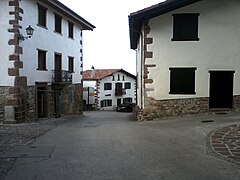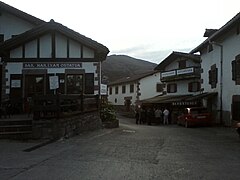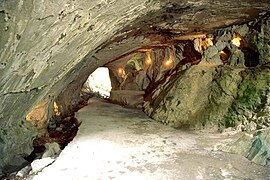Zugarramurdi
Zugarramurdi | |
|---|---|
Municipality | |
 Zugarramurdi | |
| Land | |
| Autonomous community | |
| Province | Navarre |
| Comarca | Baztan |
| Regierung | |
| • Mayor | Lázaro Dainciart Iribarren (Akelarre) |
| Area | |
| • Total | 5.6 km2 (2.2 sq mi) |
| Elevation (AMSL) | 205 m (673 ft) |
| Population (2014) | |
| • Total | 225 |
| • Density | 40/km2 (100/sq mi) |
| Demonym | zugarramurdiarra or zugarramurditarra |
| Time zone | UTC+1 (CET) |
| • Summer (DST) | UTC+2 (CEST (GMT +2)) |
| Postal code | 31710 |
| Area code | +34 (Spain) + 948 (Navarre) |
| Website | www.zugarramurdi.es |
Zugarramurdi is a town and municipality located in the province and autonomous community of Navarre in northern Spain It passed into history as the setting of alleged occult activity featured in the infamous Basque witch trials held in Logroño in the seventeenth century. The town is home to the Basque witch museum and the Cuevas de las Brujas (Witch caves). Every year, spectacular fires are lit in the caves near Zugarramurdi for the celebration of the ‘day of the witch’ on the summer solstice.[1]
Etymology
Zugarramurdi is a toponym with unknown meaning, even though it comes from Basque. The philologist Koldo Mitxelena proposed that the etymology of the name could be “place with abundancy of ruined elms”, coming from zugar(elm) + andur(ruined) + the suffix –di(it indicates abundancy). However, Mitxelena himself admitted not having proof about this theory. In Basque and in Spanish it seems that the name of the village is transcribed in the same way, although the z is pronounced differently in both languages. Because of that, the pronunciation slightly varies.
Legend
It is said that the Word “akelarre” comes from the field next to one of the small Zugarramurdi caves, where the witch meetings used to take place. The Basque word akelarre means “the field of the he-goat”. This is how those present in the meetings used to call the caves from this field, because in it a big black he-goat used to graze (called Akerbeltz in Basque). It is said that the he-goat turned into a human when the witches gathered, so it is thought that the goat was the devil itself. That is why Zugarramurdi is often called “The Cathedral of the Devil”.
Gallery
-
Street of Zugarramurdi
-
Typical architecture
-
Asunción Church
-
The "Cave of the Witches" near Akelarre in Zugarramurdi
-
Akelarre host in 2009





